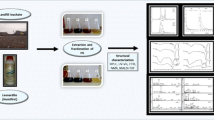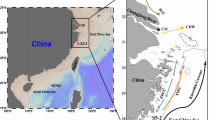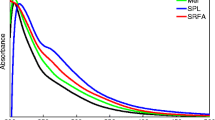Abstract
On three occasions since the late 1982, representatives of International Humic Substance Society (IHSS) have isolated standard and reference fulvic acids, humic acids, and natural organic matter (NOM) from the Suwannee River in southeastern Georgia, USA, on the southwestern boundary of the Okefenokee Swamp. Another IHSS expedition to the Suwannee River is planned in May 2012, and results from this new sampling expedition will be included in this presentation. The field and laboratory work involved in isolation of these samples will be described, along with photographic documentation of the sampling location, the methods of isolation, the personnel, etc. Chemical characteristics of the seven currently existing samples will be compared, and the impact of these samples on IHSS and on the wider scientific community will be documented.
Access provided by Autonomous University of Puebla. Download conference paper PDF
Similar content being viewed by others
Keywords
Introduction
International Humic Substance Society (IHSS) distributes its samples to scientists all over the world who study humic substances. The revenue that is generated by distribution of these samples is used to support student travel to IHSS meetings, traineeships for advanced students, travel for board members doing work for the Society, and, most importantly, to provide for replenishment of essential samples whenever the need arises. In recent years, more than 70 % of all IHSS revenue can be attributed to the samples that have been collected from the Suwannee River (Fig. 1).
Materials and Methods
IHSS samples have been collected on three prior sampling trips to the Suwannee River in southeastern Georgia, USA, on the southwestern boundary of the Okefenokee Swamp. A fourth trip will be completed in the summer of 2012. The XAD-8 resin adsorption method was used to isolate humic acids and fulvic acids in 1982–1983 and in 2003. The first standard humic acid (1S101H) and fulvic acid (1S101F) and the first reference humic acid (1R101H) and fulvic acid (1R101F) were isolated in 1982–1983 by George Aiken, Diane McKnight, Ron Malcolm, and other USGS personnel. The second standard humic acid (2S101H) and fulvic acid (2S101F) were isolated in 2003 by Mike Perdue, Jim Alberts, Monica Takács, Norbert Hertkorn, Jason Ritchie, Jean-François Koprivnjak, and Paul Bloom. The reverse osmosis (RO) method was used to isolate natural organic matter (NOM) in 1999 and will be used again in 2012. The first reference sample of Suwannee River NOM (1R101N) was isolated in 1999 by Mike Perdue, Jim Alberts, Monica Takács, and Lili Ding. Another IHSS expedition to the Suwannee River is planned in May 2012 to isolate the second reference sample of Suwannee River NOM (2R101N). Team members will include Mike Perdue, Nelson Green, Daniel McInnis, Norbert Hertkorn, and Michael Gonsior. It is anticipated that this team will process 40,000 L of river water by reverse osmosis to obtain a concentrated sample that will subsequently be desalted and freeze-dried. Summary statistics for these four sampling trips are given in Table 1.
XAD-8 Adsorption Method
In the IHSS field trips in 1982–1983 and in 2003, humic acids and fulvic acids were isolated from the Suwannee River using the detailed procedures that are given in Malcolm et al. (1989). Here are some brief details from the 2003 sampling trip, which differed slightly from the published procedures.
Briefly, river water was filtered through 0.45-μm polypropylene filters, acidified to pH 1.95 ± 0.05 with HCl, and passed through columns of XAD-8 resin to adsorb humic substances. Three parallel columns containing 9 L each of resin were operated simultaneously. After 270 L of filtered, acidified river water was loaded onto each column, the adsorbed humic substances were back-eluted from each column with 15 L of 0.1 M NaOH. The most concentrated 1 L of eluent from each column was collected, acidified to pH 4, and placed in cold storage to await further processing. The NaOH was followed by 0.1 M HCl until the eluent from the columns was acidic. All eluent solutions preceding and following the most concentrated fraction were collected separately for later retreatment. After ten 270 L samples had been processed on each of the three XAD-8 columns, the accumulated “other than center cut” concentrated organic eluates were reconcentrated as a separate run on the three XAD-8 columns.
Back in the laboratory, humic acid was precipitated at pH 1 and separated from fulvic acid. Both products were purified further and subsequently freeze-dried.
Reverse Osmosis Method
In the IHSS field trips in 1999 and in 2012, NOM was isolated from the Suwannee River using the reverse osmosis method, as described by Serkiz and Perdue (1990). Briefly, samples were concentrated 20–40 folds at the Suwannee River sampling site using a RealSoft PROS/2S portable reverse osmosis system. The PROS/2S can remove pure water from river water at a rate of 4–5 L min−1 at an applied pressure of 250 lb per square inch (PSI). In 1999, major cations were removed simultaneously using an H+-saturated cation exchange resin. An alternative procedure may be employed to desalt the concentrated NOM in 2012.
Desalted samples were further purified in the laboratory and then freeze-dried.
Results
The elemental compositions of IHSS samples from the Suwannee River are summarized in Table 2. Overall, the elemental compositions are remarkably invariant. A variety of analytical results and electronic spectra are available at www.humicsubstances.org. The basic data and other derived properties of this set of samples will be analyzed and compared.
References
Malcolm, R.L., G.R. Aiken, E.C. Bowles, and J.D. Malcolm. 1989. Isolation of fulvic and humic acids from the Suwannee River. In Humic substances in the Suwannee River, Georgia: Interactions, properties, and proposed structures, ed. R.C. Averett, J.A. Leenheer, D.M. McKnight, and K.A. Thorn, 23–35. U.S. Geological Survey, Open-File Report 87–557.
Serkiz, S.M., and E.M. Perdue. 1990. Isolation of dissolved organic matter from the Suwannee River using reverse osmosis. Water Research 24: 911–916.
Author information
Authors and Affiliations
Corresponding author
Editor information
Editors and Affiliations
Rights and permissions
Copyright information
© 2013 Zhejiang University Press and Springer Science+Business Media Dordrecht
About this paper
Cite this paper
Perdue, E.M. (2013). Standard and Reference Samples of Humic Acids, Fulvic Acids, and Natural Organic Matter from the Suwannee River, Georgia: Thirty Years of Isolation and Characterization. In: Xu, J., Wu, J., He, Y. (eds) Functions of Natural Organic Matter in Changing Environment. Springer, Dordrecht. https://doi.org/10.1007/978-94-007-5634-2_15
Download citation
DOI: https://doi.org/10.1007/978-94-007-5634-2_15
Published:
Publisher Name: Springer, Dordrecht
Print ISBN: 978-94-007-5633-5
Online ISBN: 978-94-007-5634-2
eBook Packages: Earth and Environmental ScienceEarth and Environmental Science (R0)





